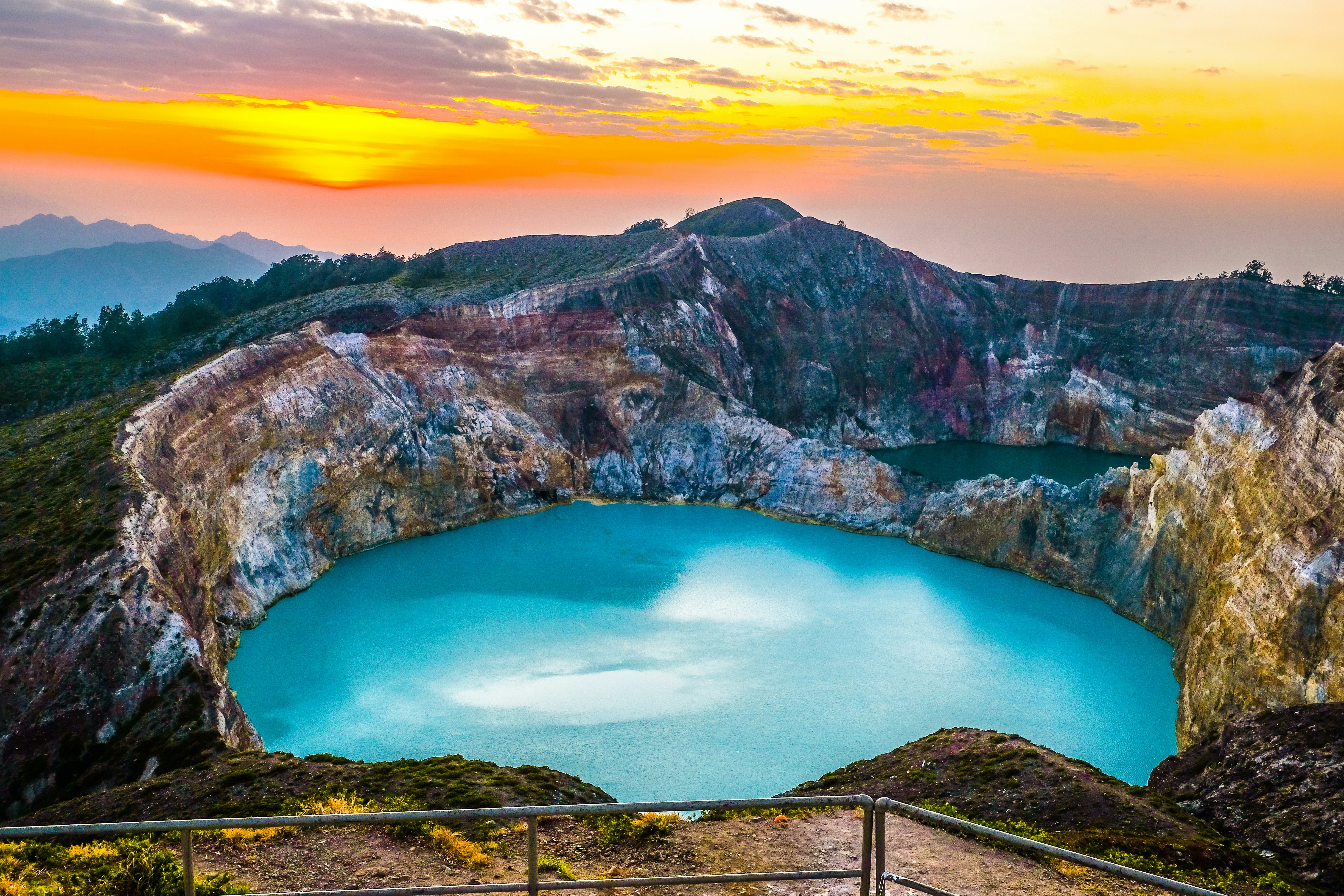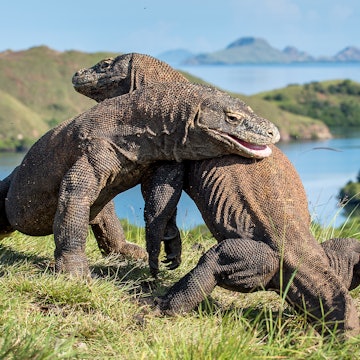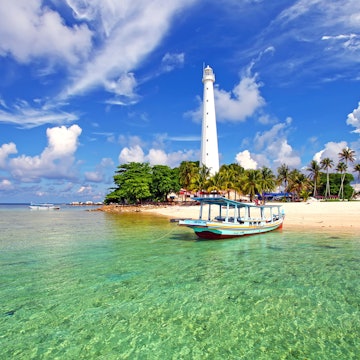

East Nusa Tenggara is a perfect Indonesian holiday destination away from the crowds. Afriandi / Getty Images
From the pink-sand beaches and world-class diving of Komodo, to the animist traditions of the villages dispersed throughout West Timor, East Nusa Tenggara’s islands are as diverse as they are enchanting. In this relatively untouched part of Indonesia, it’s still possible to have a coastline all to yourself, eat with locals at night markets and buy some of the most beautiful ikat (dyed, patterned textiles) at weekly trade markets, direct from the women who made it.
For travellers yearning for an Indonesian holiday away from the crowds with a hefty dose of culture and genuine sense of adventure, this is your destination.
Dive into technicolor reefs
Whether you’re well acquainted with creatures of the deep or it’s your first time open water diving, it doesn’t get much better than East Nusa Tenggara’s vibrant underwater worlds. Labuan Bajo is the jumping off point for famed Komodo National Park, but there are plenty of opportunities to get up, close and personal with giant manta rays, turtles, sharks and thousands of species of tropical fish well before you get there.
Prices are competitive in Bajo centre, with three-dive day trips and three-day Open Water Diver certifications popular options. Liveaboards are the die-hard’s choice, especially when diving is at its best between April and September. The Alor Archipelago is a lesser-known dive destination unless you’re into the sport, in which case you already know that dive operators there visit more than 42 dive sites. Along with its white-sand beaches and volcanic terrain, Alor is celebrated for uncrowded crystal waters and unspoiled coral reefs. Shark and dolphin sightings are common, but visit in November to catch migrating sperm whales.

Wildlife
Specific to the area, Komodo dragons grow up to 3m in length and weigh up to 150kg. Like any reptile, they’re more active at dawn and dusk – something worth taking into consideration when choosing a tour. There isn’t a widely accepted explanation as to why the dragons are only found in this tiny part of Indonesia, but their ancestors are thought to have come from Australia four million years ago. Estimates put current numbers at up to 5000 in the wild today, but the number of egg-laying females is supposedly only in the hundreds.
In July 2019, local authorities briefly considered closing Komodo Island to tourists to help revive the dragon population, but they later reversed course, instead announcing an annual membership program. Premium membership will come with a hefty price tag of USD$1000 to support infrastructure improvements on the island, though non-premium members will still be able to visit other spots the Komodo dragons call home, like the island of Rinca (where Komodo dragon sightings are even reportedly better).
Visit East Nusa Tenggara's villages
East Nusa Tenggara’s villages each have their own sets of customs, beliefs, traditions, adat (traditional law) and – in some cases – accepted constructs of time. In the village of Boti in West Timor, the charismatic kepala suku (chief) presides over a nine-day week. His people live off the land, refuse government assistance and have been operating the same way since Dutch colonists and headhunters failed to find them, keeping lives and traditions intact 21 generations later. Staying overnight in the modest accommodation and spending time with the 77 families who live here will be a highlight of your Indonesian travels.
Arrange your stay through a guide, who will be able to act as a translator and advise on what’s appropriate to bring as a gift alongside the nightly fee of 100,000Rp per person. Willy Kadati, based in West Timor, is a fantastic guide who has incredible cultural, botanic and ikat knowledge; he charges 600,000Rp per day for motorbike travel and from 1,500,000Rp for a car. Contact him through WhatsApp, 0812 5231 0678.

Another of West Timor’s preserved villages, Temkessi, is accessed through a keyhole between two limestone cliffs, 50km northeast of Kefamenanu. The people here believe that god gave their ancestors the power to command the sea, decedents still able to control the weather. A guide is necessary here, as is the customary offering of betel nut before you’re welcome to take pictures of the beehive huts built on a cliff’s edge. The island of Sumba is also home to impressive villages, the most well known being Ratenggaro. Located on a grassy bluff above a river with breathtaking views of the sea, it’s a sight to behold – even if it does feel a bit touristy.
When visiting these villages, keep in mind the local etiquette: bring betel nut as an offering, remove your shoes at any doors, be patient (Indonesia is notorious for running on its own clock) and remember that a smile goes a long way. When payment is required to visit or stay at a village, you’ll be asked to sign a guestbook. Do so, and leave your money in the book.

Hike volcanic peaks
While Labuan Bajo is becoming more popular, many don’t bother to explore the rest of Flores, which is speckled with stunning hikes through jungles and up volcanic peaks. One of the island’s main drawcards is a sacred, extinct volcano called Kelimutu. On top of the 1639m peak are three volcanic lakes, nicknamed the tri-coloured lakes. Moni, a village filled with homestays and reggae-loving locals, is the best place to sleep before you make the climb.
Wae Rebo, arguably the best Manggarai traditional village to visit, is the reward at the end of a tricky 9km hike. After three to four hours and some exquisite views, you can stay overnight in a traditional home before turning back or hiking another six hours to a different trailhead for pick up. This experience should be organized in advance with a guide. Andy Rona is a great choice, and he has a huge network of colleagues if he's booked up. Contact him by WhatsApp on 0813 3798 0855.
Another volcano worth climbing looms high above Bajwawa. At 2245m, Gunung Inerie is an eight-hour round trip, but you need to start at 3am to catch the spectacular sunrise. Alternatively, you can camp by the lake.

Surf the best of Sumba and Rote Islands
Sumba and Rote Islands are surfing hot spots. Throughout the vast island of Sumba, surfers set up at a number of small homestays and surf camps along the coast, taking daily trips out in the owners' boats to catch the best break. Those eager to stay near superior surf should stay at Sumba Adventure Resort, Marthen's Homestay, Rua Beach Resort, Sumba Surf Camp or – if you can afford it – Nihi Sumba.
Rote is a small island just southwest of West Timor with postcard beaches and some of the best surf in the world. Surfers of all abilities book up the homestays at Pantai Nemberala during peak surf season, from June to September. The beach is known for the legendary ‘left’, T-Land. Many places rent high-quality boards from about 100,000Rp per day, which can be a big help given that weather conditions often ground the small Wings Air planes that leave from Kupang and Bali. The airline charges 200,000Rp per board but doesn’t always have the space for them.
https://shop.lonelyplanet.com/products/bali-lombok-nusa-tenggara-travel-guide-17















